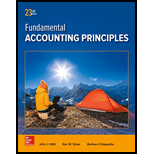
Concept introduction:
Asset: A resource which will generate a
Liabilities: During the course of the business operations, an obligation or the company’s debit that arises is called the liability. Mortgages, accounts payables, accrued expenses, loan are recorded on the right hand side of the balance sheet.
Equity: Equity is the value of an asset less the amount of all liabilities on that asset. It can be represented with the
To write: The effects of transactions of items in the accounting equation.
Want to see the full answer?
Check out a sample textbook solution
Chapter 1 Solutions
Fundamental Accounting Principles
- A fertilizer manufacturing company has an industry average P/E ratio of 20. The company's earnings per share (EPS) are projected to be $6.50. What should be the company's share price based on the industry P/E ratio?arrow_forwardNonearrow_forwardDon't use ai solution please and accountingarrow_forward

 AccountingAccountingISBN:9781337272094Author:WARREN, Carl S., Reeve, James M., Duchac, Jonathan E.Publisher:Cengage Learning,
AccountingAccountingISBN:9781337272094Author:WARREN, Carl S., Reeve, James M., Duchac, Jonathan E.Publisher:Cengage Learning, Accounting Information SystemsAccountingISBN:9781337619202Author:Hall, James A.Publisher:Cengage Learning,
Accounting Information SystemsAccountingISBN:9781337619202Author:Hall, James A.Publisher:Cengage Learning, Horngren's Cost Accounting: A Managerial Emphasis...AccountingISBN:9780134475585Author:Srikant M. Datar, Madhav V. RajanPublisher:PEARSON
Horngren's Cost Accounting: A Managerial Emphasis...AccountingISBN:9780134475585Author:Srikant M. Datar, Madhav V. RajanPublisher:PEARSON Intermediate AccountingAccountingISBN:9781259722660Author:J. David Spiceland, Mark W. Nelson, Wayne M ThomasPublisher:McGraw-Hill Education
Intermediate AccountingAccountingISBN:9781259722660Author:J. David Spiceland, Mark W. Nelson, Wayne M ThomasPublisher:McGraw-Hill Education Financial and Managerial AccountingAccountingISBN:9781259726705Author:John J Wild, Ken W. Shaw, Barbara Chiappetta Fundamental Accounting PrinciplesPublisher:McGraw-Hill Education
Financial and Managerial AccountingAccountingISBN:9781259726705Author:John J Wild, Ken W. Shaw, Barbara Chiappetta Fundamental Accounting PrinciplesPublisher:McGraw-Hill Education





